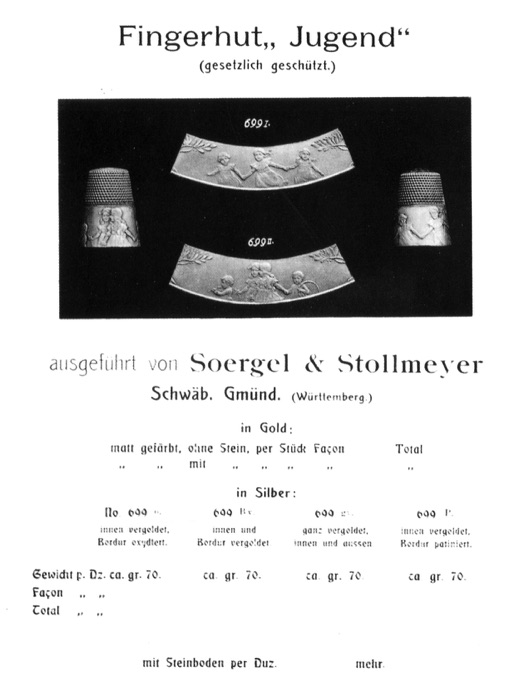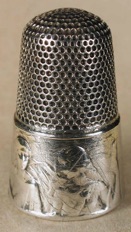More about Thimbles





Wolf-Dieter Scholz, Magdalena and William Isbister.
Recently we noticed a thimble in McConnell’s book (1) that we were unable to identify. This prompted a search of all the other well-known thimble books in an attempt to identify the unknown thimble. During this search we came across several thimbles depicting various stages of family life on German thimbles and we were unable to discover much about them in the thimble literature.
The results of our investigations are detailed in this paper.
In the early part of the last century two German thimble makers produced thimbles portraying German family life.
Gebrüder Gabler, Schorndorf.
Gabler first issued the ‘Industrious Family’ in about 1910 (fig 1). The thimble had a plain dimpled top, an applied border and rim depicting sewing ladies, children and cat playing (“Die fleissige Familie” - Artikel Nr. 1099 (2)). The thimble was designed by Prof. Christaller of Stuttgart. The thimbles were made in silver with gilt insides and either a plain or a stone top (figs 2, 3) or in gold (585). The thimbles had the designers name on the rim but it was usually very difficult to read. Professor (Paul) Christaller was born in Basel in 1887 and was a Professor at the "Kunstakademie" in Stuttgart.



Fig 1 Fig 2 Fig 3
Gabler made a second thimble (fig 4) around the same time depicting a family scene. It was called the ‘Family idyll’ (Familienidyll). The thimble had a plain dimpled top with an eight pointed star, the border and rim depicted a granny with her grand daughter sewing, a mother and her daughter, and a husband and his wife sewing. The inside was gilded.


Fig 4
Both of these thimbles were re-issued by Thorvald Greif who was a distant descendant of Gabler and whose father had acquired the remaining Gabler stock, dies and designs in 1982.


Fig 5
The bands of the re-issued thimbles are applied to the thimble and the rim is rounded (fig 5). They are marked with a ‘G’ and 925, where as the original thimbles were only marked with the silver fineness mark of 800.
There seems to have been a further ‘family’ band (fig 6) that was in the Greif possession but as far as we can determine it was never actually used on a thimble.

Fig 6
Soergel & Stollmeyer, Schwäbisch Gmünd
Soergel and Stollmeyer, around the same time that Gabler were producing their original ‘family’ thimbles, made two ‘family’ thimbles of their own called ‘the youth’ (‘Die Jugend’ (models 699 l & ll)) (fig 7).

Fig 7
The first model (fig 8) had a plain dimpled top with an applied border and rim depicting a child with a hoop, a girl holding the hoop with another girl by her side and a second child holding another hoop. The inside was gilded.



Fig 8 Fig 9 Fig 10
In addition to the silver fineness mark of 800 there was a ‘S’ in a triangle on the side of the thimble (fig 9) and an eight pointed star on the top (model 699 l). The second model (fig 10) depicted three girls holding hands and a tree at the join of the band. There was an ‘S’ in a triangle on the top of this thimble instead of the star (model 699 ll).
Julius Wengert eK, Pforzheim
Julius Wengert is a contemporary thimble maker. In the eighties, at the time of the Gabler re-issues, he made copies (fig 11) of the ‘Family idyll’ thimbles (Familienidyll-Nähende Familie). The copies did not have a rim and the decoration was not so sharp as the moulding from the cleaned up Gabler dies. The thimble was marked 925 M in the top (fig 12).


Fig 11

Fig 12
Unknown maker
A thimble commemorating the women of the first World War has an eight pointed star on the top, a plain border with “Hommage a la Femme de 1914-15" and family scenes including a wounded man being treated by a woman (fig 13). It has a plain round rim, is marked ‘0.800’, and has a gilt interior.

Fig 13
This thimble was possibly made by Lotthammer – Eber of Pforzheim.
Conclusion
This small study has enabled us to identify six ‘family’ thimbles which were made by German makers in the last century. We have unfortunately not been able to identify the maker of one of our thimbles with any certainty. Two of the thimbles identified initially were re-issued, one by two makers. It is hoped that by illustrating the thimbles other collectors will be able to identify their ‘family’ thimbles more easily. It seems probable that the McConnell thimble must have been French!
Reference
1. McConnel B. The story of the thimble. Atglen, PA.: Schiffer Publishing Ltd, 1997. pp .115
2. Christie’s Sale 5443. Thimbles & Needlework Accessories, 30th October 2007, London, South Kensington.
TCI Bulletin Summer 2011
Holmes: ‘Thimbles of Germany’ pp. 24, and ‘Children’s Thimbles’ pp. 167.
Addendum
Since writing this paper we have been able to identify the McConnnel thimble. It was, in fact, a French thimble, engraved by Pierre Charles Lenoir and depicts girls sewing. The maker is unknown but the thimble dates to around 1900.

Researched and published in 2002/11
Copyright@2011. All Rights Reserved
Magdalena and William Isbister, Moosbach, Germany
Addendum 1/2013
It appears that although Thorvald Greif had a complete set of thimble making machines, obtained from Lotthamer, in his cellar, he was not able to produce thimbles with them. When he used the original Gabler dies to make bands for his re-issued thimbles (Fig 5) he first used old Gabler thimbles but when these ran out he obtained thimbles from Julius Wengert in Pforzheim. Some of these re-issues thus have both Greif (G) and Wengert (Fig 12) marks.
German ‘family’ thimbles
Navigation
